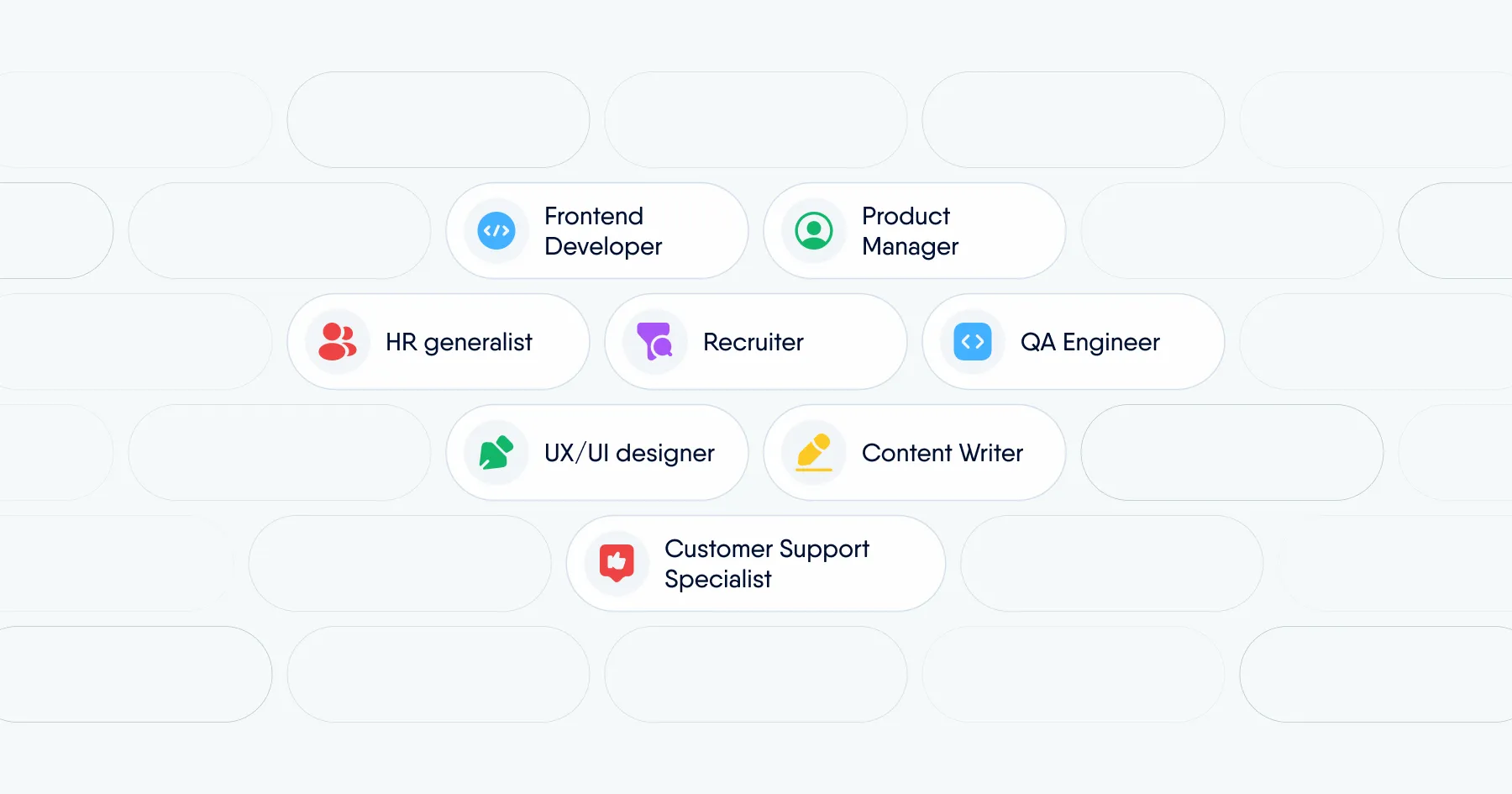
10 simple steps to implement OKRs in your organization
Back in 1999, venture capitalist John Doerr introduced the OKR method to a small startup in Silicon Valley. A few years later, that company became a household name – Google. Since then, hundreds of organizations around the world have adopted OKRs to improve focus, alignment, and performance. Wondering if it could work for your team too? Here's how to get started – step by step.
What are OKRs (Objectives and Key Results)?
OKRs (Objectives and Key Results) are a goal-setting framework that helps teams define what they want to achieve and how they’ll measure success.
- The Objective is the goal: bold, motivating, clearly defined, and easy to remember.
- The Key Results are the measurable outcomes that show whether the objective has been met. To stay focused, each objective should have no more than five key results.
John Doerr captured the essence of OKRs in a simple formula:
“I will [Objective] as measured by [this set of Key Results]”.
Let’s say your objective is to improve the onboarding experience for new hires. Your key results might look like this:
- Interview five recently hired employees about their onboarding experience.
- Implement at least three process improvements based on their feedback.
- Reach an average onboarding satisfaction score of 4.5/5 in the first-month survey.
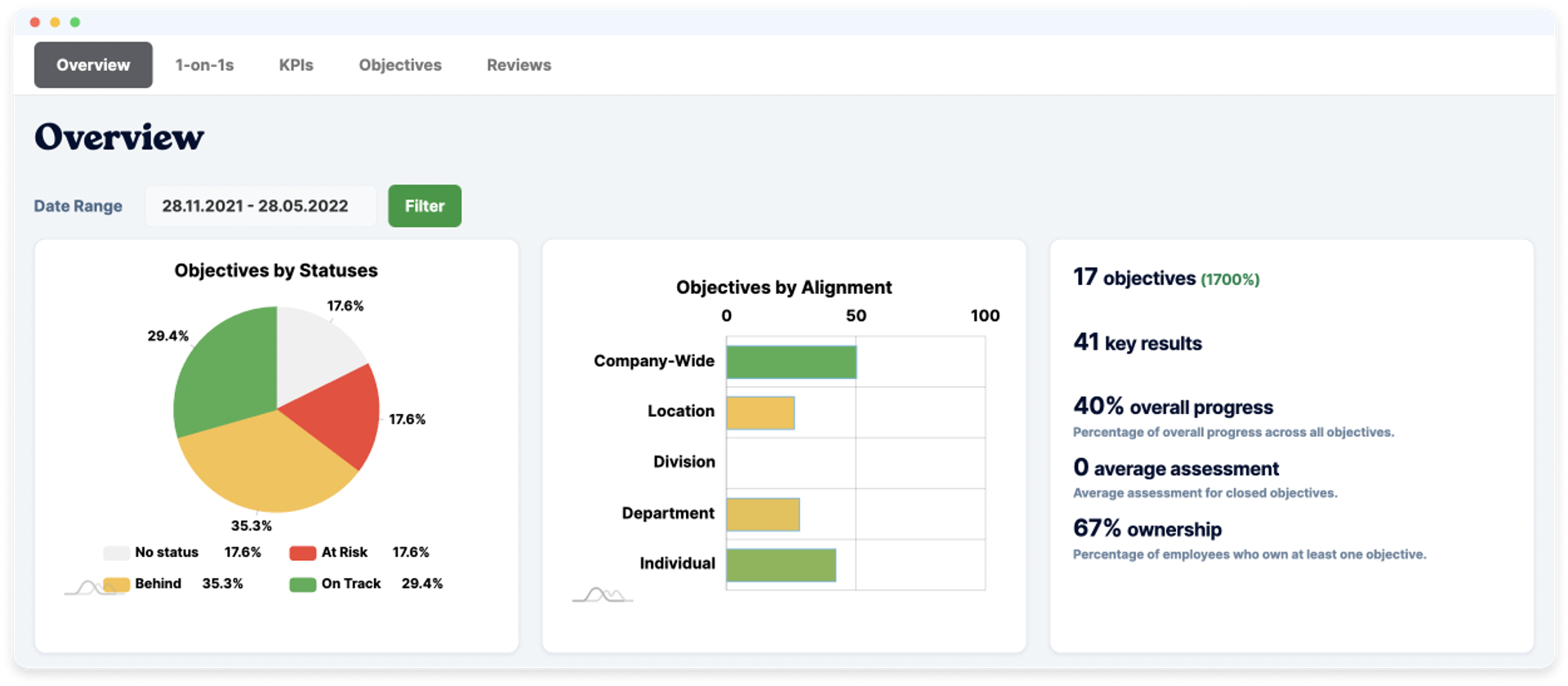
The benefits of OKRs – what they really bring to your organization
When implemented effectively, OKRs can help your organization:
- Clearly define and communicate priorities;
- Set ambitious yet realistic challenges for your team;
- Focus on what truly matters to your customers and the business as a whole;
- Improve collaboration within teams and across departments;
- Boost employee engagement;
- Connect day-to-day tasks with broader business goals – creating a clear and meaningful path toward results.
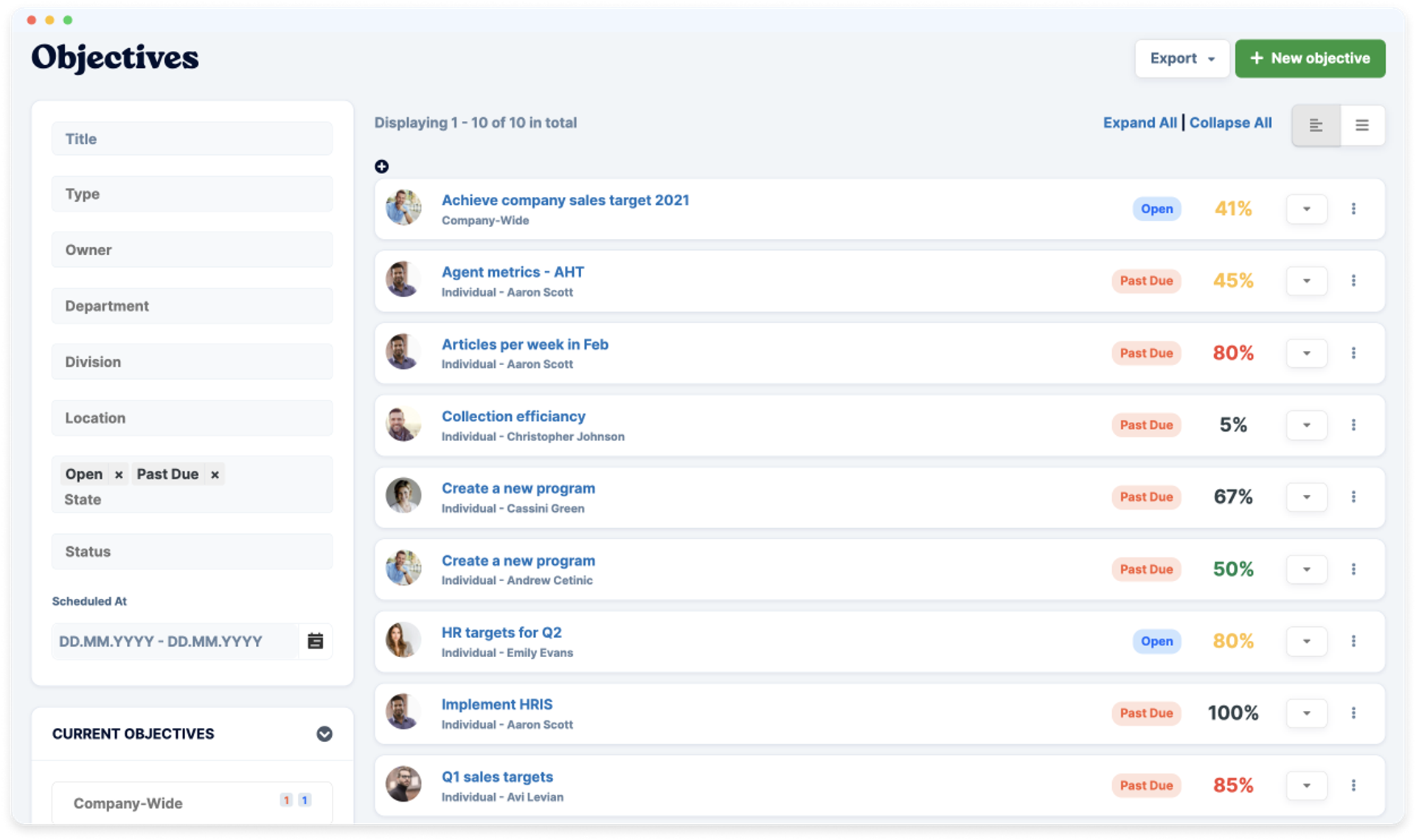
10 steps to successfully roll out OKRs in your organization
Implementing the OKR methodology helps bring structure to goal-setting and creates more transparency across the organization. Here's a practical step-by-step checklist to guide you through the process.
1. Introduce your team to the new approach
Start by familiarizing your team with the OKR framework and what it means for their day-to-day work. Explain how the goal-setting process will change, what the shift involves, and what benefits it can bring. Open communication is key – some team members may feel uncertain or have concerns.
Be ready to answer common questions like:
- Are OKRs just another reporting requirement? 👉 Not at all. OKRs are a focus tool, not a tracking or control mechanism. They help teams align around what truly matters.
- Will OKRs affect my performance review? 👉 No. OKRs are meant to set direction and priorities, not to evaluate individual performance.
- Does this mean we’ll have more meetings? 👉 Yes, but they’ll be shorter and more focused.
Allow for a transition period of about three weeks before the official launch. Use this time for Q&A sessions, internal conversations, and adaptation. Share examples of how other companies have successfully implemented OKRs to make the concept more tangible.
2. Define the time frame
Decide on the time period during which key objectives should be achieved. In practice, a quarterly cycle is the most common – it offers a good balance of momentum, allows for regular progress tracking, and gives you flexibility to adjust course if needed.
Time frames should be clearly defined at every level – across the organization, within teams, and for individual contributors.
3. Create cascading goals
Plan strategic objectives and break them down logically into team and individual goals. This helps ensure that every level of the organization contributes meaningfully to shared priorities. The key is alignment – each layer of goals should connect and reinforce one another to form a cohesive structure.
For example:
- At the organizational level, define three to five high-level objectives based on the organization’s top priorities for the quarter. Each objective should be ambitious but achievable within three months.
- At the team level, choose one or two organizational goals that the team can directly support. In addition, each team can set up to two goals specific to their area of work. Altogether, teams should focus on no more than four goals per cycle.
- At the individual level, set goals based on the person’s role and scope of responsibility (no more than five per person). Each goal should strike a balance – not so easy that it lacks motivation and not so difficult that it feels out of reach from the start. Individual OKRs are optional.
4. Make sure your team understands the goals the same way you do
During the planning phase, people may interpret goals differently. Make sure everyone shares the same definitions and follows the same guidelines. Misalignment in how goals are understood can easily lead to wrong assumptions and inconsistent execution.
How can you handle this in practice?
- Ask a few team members to explain the goals in their own words;
- Discuss how a specific goal impacts the organization’s customers;
- Check whether everyone understands why these particular goals are a priority;
- Create visual aids to show how different goals are connected.
5. Define measurable key results
For each objective, define up to five measurable key results. Each one should clearly indicate whether the goal has been achieved. A simple formula can help you stay on track:
“Increase / decrease / achieve [what] – from [starting value] to [target value] – by [deadline]”
Example: Decrease turnover during the probationary period – from 18% to 10% – by the end of the half-year.
Key results should be specific, measurable, and easy to evaluate. Depending on the nature of your objective, you can use metrics related to growth, quality, activity levels, or clearly defined milestones.
A well-crafted key result should be so clear that even someone outside the team can tell whether it’s been met – no further explanation needed.
6. Set up a system for regular progress tracking
Successful OKR execution depends on consistent follow-up. A clear division of responsibilities and scheduled check-ins make it easier to track progress and respond quickly when challenges arise. Everyone should know what they’re working toward, how much time they have, and when the next check-in will happen.
Your tracking system should include:
- Weekly 15-minute team check-ins to align on current priorities and next steps for the week;
- Monthly progress reviews for team leads and managers focused on deeper analysis and course correction if needed;
- Quarterly retrospectives with the entire team and leadership to review and evaluate the full OKR cycle.
7. Reevaluate the number of goals
During the OKR cycle, you may notice that some individuals or teams are trying to take on too many goals at once. To avoid overload and the risk of burnout, it's worth narrowing the focus to only the most meaningful objectives.
Use a few simple criteria to prioritize:
- Customer impact – which goals create the most value from the customer’s perspective?
- Business urgency – what needs to happen now, and what can wait?
- Feasibility – do we have the right resources and competencies needed to achieve this goal?
- Measurability – can we clearly assess progress and success?
It’s better to fully accomplish three well-chosen goals than to only partially complete five.
8. Evaluate the results achieved
Not every goal will be fully accomplished – and that’s perfectly normal. What matters most is that, at the end of the cycle, each key result is evaluated based on the criteria you set at the beginning.
- If a result fell short, dig into the “why”. Not to blame, but to learn.
- If it did, take a moment to celebrate the success – whether it’s yours, a colleague’s, or the team’s.
- If your team consistently hits 100% of all key results, it’s time to raise the bar. Easy goals can lower engagement over time.
9. Analyze and learn from the cycle
Once the OKR cycle ends, take time to review both the results and the process itself. If you’re using an HRM system with OKR functionality, check the reports and data to see what worked and what needs improvement.
This is your chance to identify what went well, surface any challenges, and prepare for the next phase of working with OKRs.
10. Plan adjustments and start the next cycle
OKRs run in recurring cycles – and each one is a chance to improve. Turn the insights from your review into concrete changes. Gather feedback from the team, revisit your goal structure, refine your workflow, or adjust your planning process.
Adapt your approach to fit your organization’s needs – and kick off the next cycle with focus and clarity.
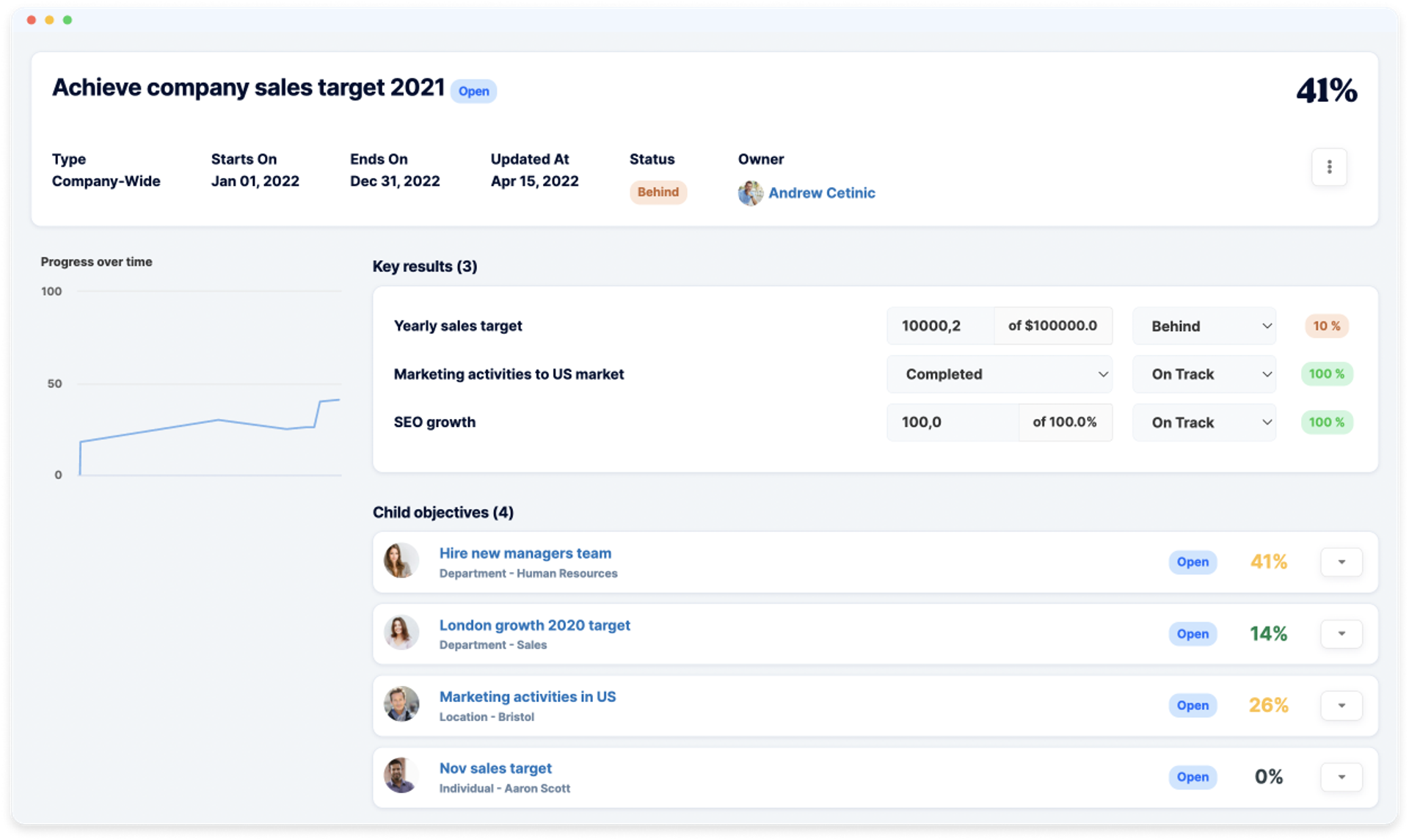
Key takeaways – why OKRs are worth trying in your team
Many organizations struggle to turn strategy into meaningful day-to-day actions. The OKR method helps solve that problem. It’s built on a simple structure: a clearly defined objective and a set of measurable key results that make it easy to track progress and evaluate what’s working – and what’s not.
Instead of long to-do lists, teams get clear, aligned direction focused on what really matters.
Thanks to its flexibility, the OKR framework works well for both large enterprises and smaller companies – regardless of industry or organizational complexity. It’s used by well-known names like Google, Intel, Netflix, Deloitte, Adobe, and many more.
Use our checklist to give OKRs a try with your team. You can even start with a small pilot cycle. You might be surprised by how much easier, more focused, and more rewarding goal-setting can become.
Get started with PeopleForce today
Automate your HR routine to create a high performance culture in your company. PeopleForce is your best HRM alternative to stay business driven but people focused.
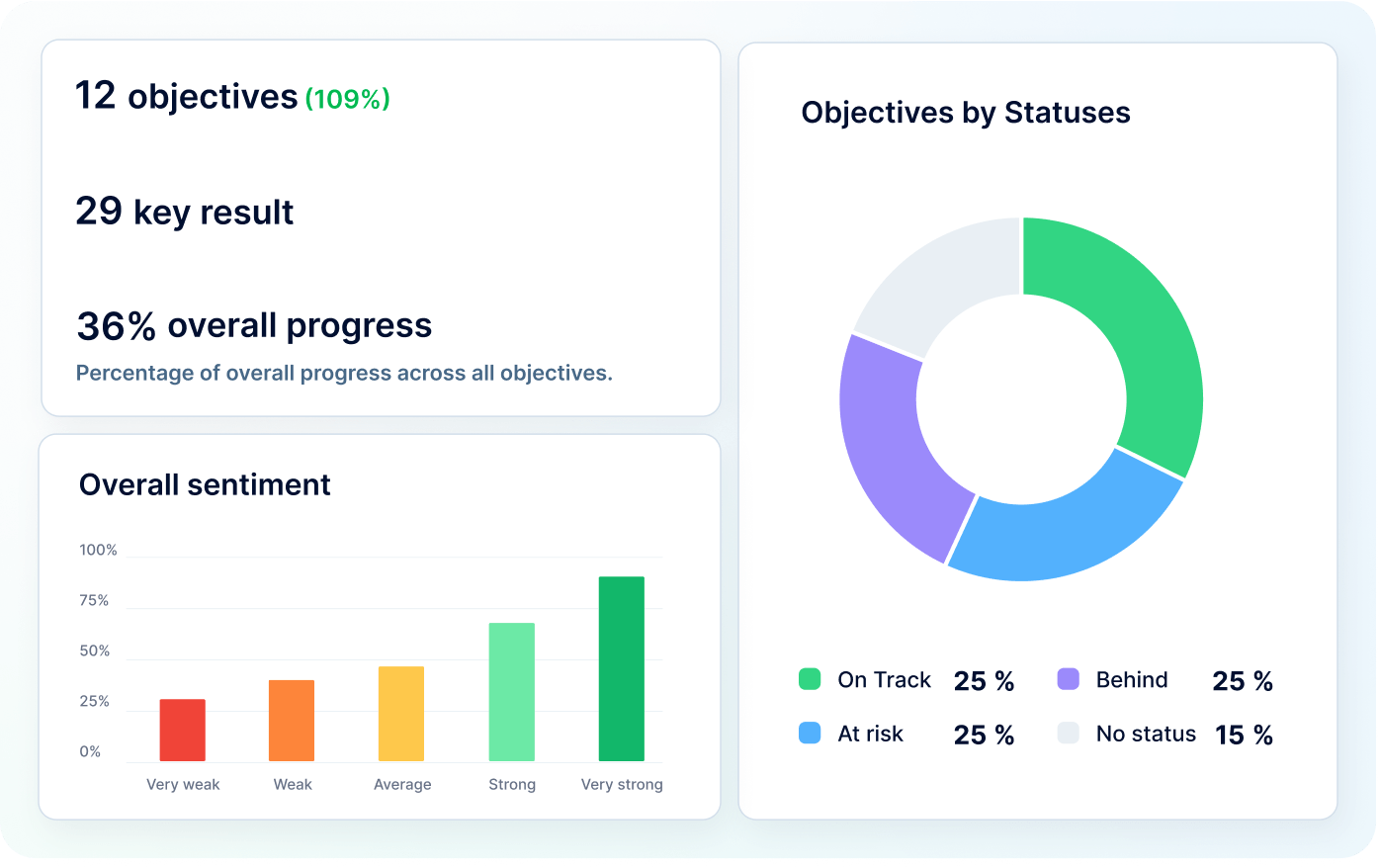
Recent articles
7 personal development habits worth adopting for career and personal growth
Unlock your potential with 7 simple personal development habits to boost career growth, productivity, and overall life balance.
Will AI take our jobs? Myths and truths about the 8 popular IT and tech roles
AI – tool or job replacement? Should you be afraid that AI will take your job? You won’t know until you read this article.
Comparing the top 10 HRM systems: How to choose the best one?
Struggling to choose the right HRM system for your team? Want to know which platform offers the best value, features, and support? We’ve compared the top 10 HRM solutions to help you decide — with real user ratings, pricing breakdowns, and key use cases.

